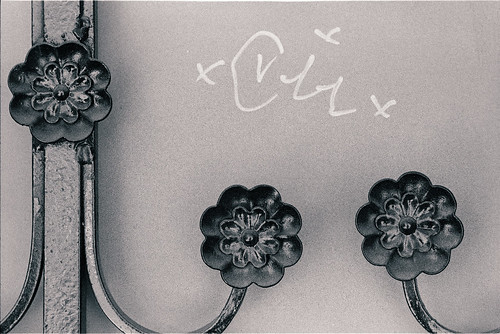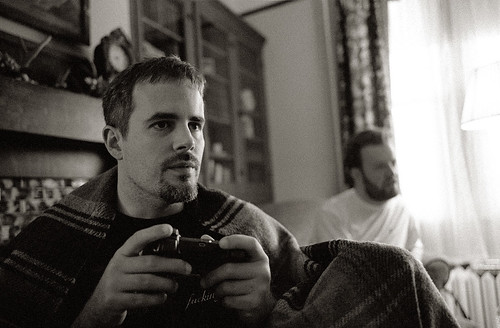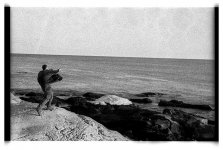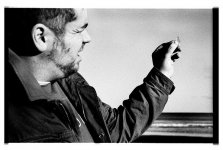filmfan
Well-known
Edit by user.
Zonan
Well-known
I'm pretty sure Chris Crawford has posted a number of those here- I think he's shooting his Doll House project with it.
Also look at http://filmdev.org/ , a flickr-related site
Rick
Also look at http://filmdev.org/ , a flickr-related site
Rick
Tim Gray
Well-known
Good stuff. I develop in XTOL 1:1. Rate it at 1600 for better shadow detail than at 3200. It works good at 800 too. You can obviously go to 3200 with it, but I don't do that unless I need to. I've not needed to extend development over what's in the TMZ and XTOL tech pubs. Stuff prints just fine between grades 2 and 3, which gives me plenty of wiggle room on any side if I wanted to go there. Here's an example of a darkroom print of one of the scans below.
Here's several examples. Sorry for posting so many pictures, but I put some up exposed at 800, 1600, and 3200, and in different lighting.





You can find more here.
Here's several examples. Sorry for posting so many pictures, but I put some up exposed at 800, 1600, and 3200, and in different lighting.





You can find more here.
filmfan
Well-known
Tim Gray, great examples. I just processed a roll shot @3200 and am waiting for it to dry.
Juan Valdenebro
Truth is beauty
Do your own testing... And there's no such thing as a best developing time... One time is good for a scene and its contrast, but horrible for other scenes and their contrast... Even in low light you can have hard or soft light, and differences in developing times are huge: several minutes... It's not absolutely necessary to waste a roll or two in testing... You can shoot for real photographs along your testing for exposure and development... Well, I guess that's what you're doing already... And yes, normally longer times than recommended are better...
Cheers,
Juan
Cheers,
Juan
Chriscrawfordphoto
Real Men Shoot Film.
I just purchased 8 rolls of this stuff from a RFF member and was wondering, since I have never used the stuff before, what I am going to get from it. Please post a photo with development information if you have it so I can plan my usage accordingly. From what I have heard, Tmax and Xtol developers work best, and I have also heard that a bit of over-developing never hurts...
Thank you very much,
-S.
Develop it for the times Kodak recommends in Tmax developer. That's how I've gotten the best results. I usually shoot it at EI-1600 and develop it for Kodak's recommended 1600 time.




Rob-F
Likes Leicas
Do your own testing... And there's no such thing as a best developing time... One time is good for a scene and its contrast, but horrible for other scenes and their contrast... Even in low light you can have hard or soft light, and differences in developing times are huge: several minutes... It's not absolutely necessary to waste a roll or two in testing... You can shoot for real photographs along your testing for exposure and development... Well, I guess that's what you're doing already... And yes, normally longer times than recommended are better...
Cheers,
Juan
I agree with most of that. I don't agree that longer development is usually better. Let's say you like your steak about medium-rare. Would you leave in the broiler another two minutes just to make sure? Of course not! I would rather take the opposite approach with film by keeping the development time a bit to the short side until I really get a feel for the film and developer I'm using. I can always reach for a higher contrast filter if the developing time is on the short side. Trying to blast through the blocked highlights of an overdeveloped negative is another matter!
Juan Valdenebro
Truth is beauty
Rob, I don't block my highlights... If I develop longer than others, it's because I expose accordingly... Apart from that, the effect of multigrade filters is not the same as what you get with other level of contrast on negative because of different expo/dev...
But well, to each their own... When in a previous post I wrote I was using 15 minutes with TMax developer 1+4 at 24ºC for TMZ, someone came saying "oh, you must adore huge grain and crazy contrast" or something like that... Then I had to teach him what he thought he knew well... But maybe he wasn't interested in learning anyway... My print wasn't high contrast, and had small grain... That's what happens in most forums... Another thing that's always impressed me is how easily people scan in different ways, change their scanned negatives in photoshop as much as they can press them, and then post any image that's far from their original negative and try to set public rules... That's why this time I just said do your own testing... And that's why my last two posts on TMZ were wet prints... And the last crazy thing, again usual on forums is saying "I expose at..." referring to camera ISO setting when that means nothing: with reflected average metering the shot could have been exposed far from that ISO... Another one: suggested developing times are generally used to start testing and then testing extending development, not to make it shorter... Box speed ISO is a war between brands... If you expose at that speed, of course you get an image, but shadows are compressed... Even if you scan, you won't be able to separate them if they're flat on your original (negative)... And definitely yes: longer developing times are better, because tone is clean and film holds a lot of detail in the highlights you can work comfortably when printing... Scanning is a more limited game both for capturing range from negative and for printing... So, filmfan, you can get wonderful results from TMZ in a real wide range: 7 to 15 minutes with TMaxDev, with ISOs from 800 to 3200 and more if metering in camera. This is not imagination, scanning and correcting low quality negatives in photoshop, but incident metering, precise developing and direct wet printing, the game known as photography since it was born...
Cheers,
Juan
But well, to each their own... When in a previous post I wrote I was using 15 minutes with TMax developer 1+4 at 24ºC for TMZ, someone came saying "oh, you must adore huge grain and crazy contrast" or something like that... Then I had to teach him what he thought he knew well... But maybe he wasn't interested in learning anyway... My print wasn't high contrast, and had small grain... That's what happens in most forums... Another thing that's always impressed me is how easily people scan in different ways, change their scanned negatives in photoshop as much as they can press them, and then post any image that's far from their original negative and try to set public rules... That's why this time I just said do your own testing... And that's why my last two posts on TMZ were wet prints... And the last crazy thing, again usual on forums is saying "I expose at..." referring to camera ISO setting when that means nothing: with reflected average metering the shot could have been exposed far from that ISO... Another one: suggested developing times are generally used to start testing and then testing extending development, not to make it shorter... Box speed ISO is a war between brands... If you expose at that speed, of course you get an image, but shadows are compressed... Even if you scan, you won't be able to separate them if they're flat on your original (negative)... And definitely yes: longer developing times are better, because tone is clean and film holds a lot of detail in the highlights you can work comfortably when printing... Scanning is a more limited game both for capturing range from negative and for printing... So, filmfan, you can get wonderful results from TMZ in a real wide range: 7 to 15 minutes with TMaxDev, with ISOs from 800 to 3200 and more if metering in camera. This is not imagination, scanning and correcting low quality negatives in photoshop, but incident metering, precise developing and direct wet printing, the game known as photography since it was born...
Cheers,
Juan
anu L ogy
Well-known
kshapero
South Florida Man
Would PP with Noise Ninja or some other noise removal software smooth it out a little more?
Chriscrawfordphoto
Real Men Shoot Film.
Chris,
Really nice examples, I especially care for the shot of the woman, and the last one you posted.
Anyways, I really enjoy shooting with this film, it has a great look to it and can be shot at a lot of different speeds.
Thanks. That old woman was 91 years old when I took that picture. She still ran the bar that her father opened back in the 1930s in the little town of Cerrillos, New Mexico. She was one of the first women to graduate from the University of New Mexico and was a teacher until she had her own children, then she quit teaching to be a housewife and help in the family's bar.
Tim Gray
Well-known
Juan, I definitely agree about the testing part and seeing what you like. Though I scan a lot of my negatives, wet printing is how I produce my prints. If longer times work for you with the way you print and agitate, then great.
I've found the Kodak's times for TMZ in XTOL are pretty much in the right ballpark for wet printing for me (and my agitation style). One might want to adjust the times a bit depending on your enlarger, paper, etc., but I have no problems making prints of my negatives on normal grades, like 2 or 3. That's why I post a link to a scan of a wet print and the image from the neg scan at the same time. I think they are pretty close in terms of tones, without any great effort on my part.
I've found the Kodak's times for TMZ in XTOL are pretty much in the right ballpark for wet printing for me (and my agitation style). One might want to adjust the times a bit depending on your enlarger, paper, etc., but I have no problems making prints of my negatives on normal grades, like 2 or 3. That's why I post a link to a scan of a wet print and the image from the neg scan at the same time. I think they are pretty close in terms of tones, without any great effort on my part.
Juan Valdenebro
Truth is beauty
That's a beautiful portrait, Chris... And a great story too... Apart from that, a very well exposed and developed shot, being such a difficult light situation: highlights are well controlled, and shadows are detailed and separated... I enjoy that!
Cheers,
Juan
Cheers,
Juan
Juan Valdenebro
Truth is beauty
Tim, but do you see "a recommended time" can not work for different contrast scenes? It's very simple...
Tim Gray
Well-known
Absolutely. Just like 'overdevelop' doesn't work for different contrast scenes 
The way I look at it, for a film like TMZ with developers like XTOL or TMAX dev, all of which have good spec sheets, the provided times are as good of a start as any. If the first roll takes a lot of jumping through hoops to print or scan, shorten or lengthen your dev time.
Great photos Chris. I hope they coat some more TMZ soon...
The way I look at it, for a film like TMZ with developers like XTOL or TMAX dev, all of which have good spec sheets, the provided times are as good of a start as any. If the first roll takes a lot of jumping through hoops to print or scan, shorten or lengthen your dev time.
Great photos Chris. I hope they coat some more TMZ soon...
Juan Valdenebro
Truth is beauty
What I mean, is that we should never say "X film works great in Y developer for Z minutes", because one time doesn't fit several situations, so we should recommend "for hard light 7 minutes and for soft light 12 minutes" as a minimum,,. And a thing that would be great: not mixing wet prints and scans in the same thread... That would be so nice... I enjoy a lot Erik van Straten's posting: he posts wet prints, and it's a pleasure seeing both parts of the game: what he sees, and what he gets from his materials...
Cheers,
Juan
Cheers,
Juan
Juan Valdenebro
Truth is beauty
Absolutely. Just like 'overdevelop' doesn't work for different contrast scenes
The way I look at it, for a film like TMZ with developers like XTOL or TMAX dev, all of which have good spec sheets, the provided times are as good of a start as any. If the first roll takes a lot of jumping through hoops to print or scan, shorten or lengthen your dev time.
Great photos Chris. I hope they coat some more TMZ soon...
Tim, the point is that it isn't "overdevelop" as you insist, but perfect developing for a given soft light scene after a given exposure I decided. And the proof is the wet print, not my words.
Cheers,
Juan
Chriscrawfordphoto
Real Men Shoot Film.
Tim, the point is that it isn't "overdevelop" as you insist, but perfect developing for a given soft light scene after a given exposure I decided. And the proof is the wet print, not my words.
Cheers,
Juan
There are a lot of things that go into the 'correct' time for each person. How accurate is your exposure meter? Your camera's shutter? Is your darkroom thermometer correct? How much do you agitate? What kind of paper you print on (or if you scan, how does your scanner render tones?). I think Kodak's times for Tmax 3200 are perfect, but that's because I'm lucky enough that all those factors mentioned above fall into place for me. Also, part of it is just the look you want; if you like higher contrast you will want a longer time, and if the scene itself is low contrast you may want more time.
Chriscrawfordphoto
Real Men Shoot Film.
That's a beautiful portrait, Chris... And a great story too... Apart from that, a very well exposed and developed shot, being such a difficult light situation: highlights are well controlled, and shadows are detailed and separated... I enjoy that!
Cheers,
Juan
It was harder than I made it look to pull off! The light came ENTIRELY from a window on one side of the scene. Mary had the lights off in the bar and the windows are only on the front of the building, and they're partly covered in signs. I had to do a lot of burning in of things on the right side of the photo to balance the light.
Juan Valdenebro
Truth is beauty
It was harder than I made it look to pull off! The light came ENTIRELY from a window on one side of the scene. Mary had the lights off in the bar and the windows are only on the front of the building, and they're partly covered in signs. I had to do a lot of burning in of things on the right side of the photo to balance the light.
Very well done!
Share:
-
This site uses cookies to help personalise content, tailor your experience and to keep you logged in if you register.
By continuing to use this site, you are consenting to our use of cookies.


